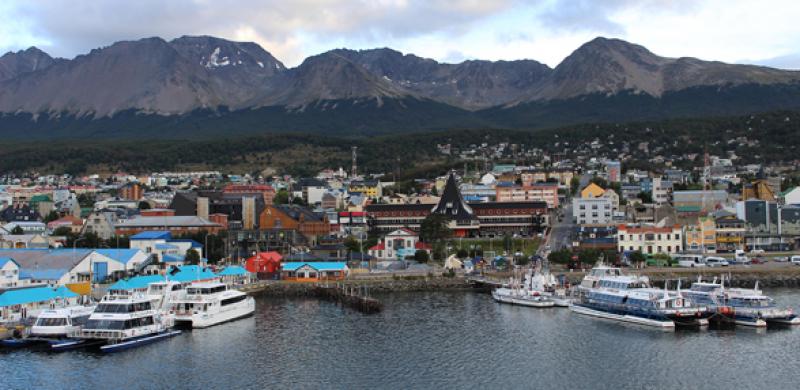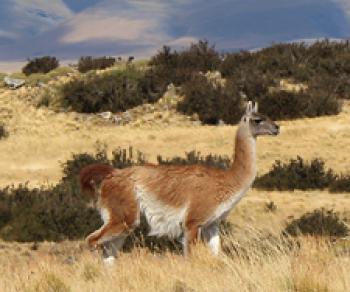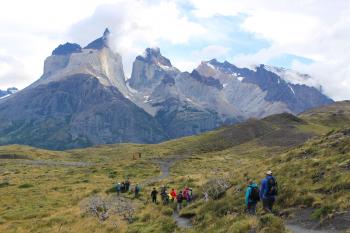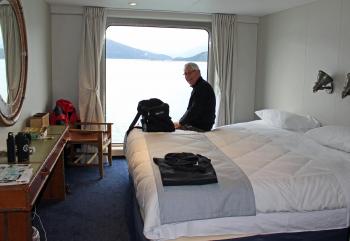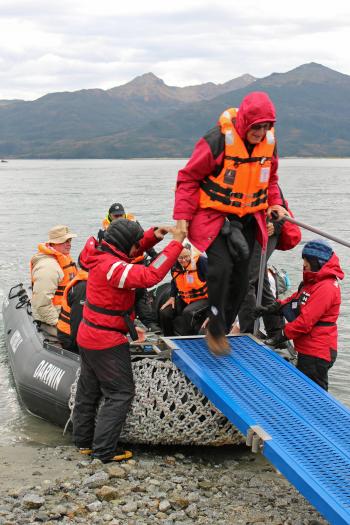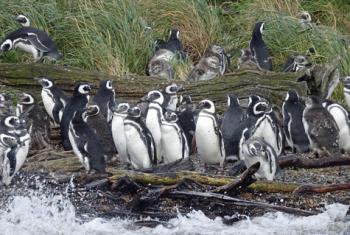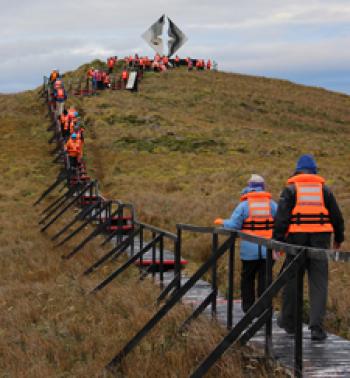Getting the most out of Patagonia
This item appears on page 26 of the June 2019 issue.
My husband, Ray, and I joined 24 travelers on the tour “The Wilderness Beyond: Patagonia, Tierra del Fuego & the Chilean Fjords,” Feb. 12-27, 2018, with Overseas Adventure Travel (Boston, MA; 800/955-1925, www.oattravel.com).
The total cost for the two of us was $13,190, which included three nights in Buenos Aires, round-trip air from Orlando, AIG trip insurance and tips, food and incidentals.
The Patagonian Steppe is an expansive barren scrub with long distances between impressive glaciers and unique mountains. Our tour’s gateway to the steppe was El Calafate, Argentina, which is near Parque Nacional Los Glaciares, named for the 47-plus glaciers within its boundary.
The park’s northern sector, with Mount Fitz Roy, is accessible only to trekkers. Our group hiked in the southern sector to Glaciar Perito Moreno, an impressive, 30,000-year-old, 20-mile-long river of blue ice. Its massive wall of craggy ice pillars rose 200 feet above Lago Argentino!
I felt that spending two nights in El Calafate was adequate. The next day, we rode three hours to Torres del Paine National Park in Chile.
When our group entered the park, the weather was sunny and bright, with temperatures in the 50s. There had been so few wildlife sightings in the steppe, we eagerly watched for jackrabbits and the occasional rhea. Seeing a guanaco was a treat!
As we continued south across the park, the region’s reputation for “the foulest weather on Earth!” emerged, with brisk wind and chill rain. We donned our waterproof, windproof gear from a previous Antarctic trip. We learned that rain, sleet or snow could occur at any moment, and then, within a few hours, the sun might return.
Located just outside Torres del Paine, the comfortable Rio Serrano Hotel (www.hotelrioserrano.cl) provided ample areas with impressive views of the Paine Massif. Ray and I enjoyed watching the light play on the moody mountains as we explored the hotel grounds.
The hotel offered expansive buffets, a cozy bar and a full expedition team, who led a broad range of activities for guests of different interests and abilities. (Our tour used its own guide, however.)
Minimally, four nights at the Rio Serrano Hotel would be enough to enjoy the park’s unique features during optimal weather. We wish we could have stayed at least five instead of only two.
Our itinerary included three short hikes. My favorite took us past Salto Grande waterfall toward the Mirador Los Cuernos. Fierce winds descending off the mountains wobbled hikers and gnarled trees.
The stunning peaks of Cuernos del Paine consist of a sheer wall of light-gray granite crowned by a jagged horn of dark-brown metamorphic rock — a distinctive centerpiece for the park.
Unfortunately, we did not have enough free time to take the locally offered and highly rated “Grey Glacier Boat Tour.”
Our next hotel, a 2-hour ride away in Puerto Natales, was the Costaustralis (Pedro Montt 262; www.hotelcostaustralis.com/en), well located on a long waterfront promenade with a ferry dock, Monumento al Viento (Monument to the Wind) and Muelle Histórico, an old pier filled with seabirds. Black-necked swans bobbed in the water.
If we had had an extra night there, we might have had time to explore the city’s Plaza de Armas and sail to a nearby glacier.
Punta Arenas was three hours away, but en route our group took a lengthy detour for an asado, a Patagonian barbecue, at what I felt was a touristy sheep ranch. Consequently, when we reached Punta Arenas, we had only a couple of hours to independently explore the city.
The Centro Cultural Braun-Menendez was closed for routine maintenance. Instead, Ray and I (for $3 each) hurried through the Palacio Sara Braun, completed in 1895 and now a hotel and restaurant. We then bolted through the Cathedral, saw the Memorial to Ferdinand Magellan and walked to the Costanera, where cormorants as well as harbor activity mesmerized us until we had to run for our ship, the Ventus Australis.
If we had had three nights in Punta Arenas, we could have explored the historic Cementerio Municipal and booked a local tour to Isla Magdalena* to walk among its Magellanic penguins and sea lions.
•
Once our tour group merged with others on the ship, there were 210 travelers for the 4-night, southbound “Fjords of Tierra del Fuego” cruise. Ray and I were in cabin 419, which, at 177 square feet, was compact but comfortable, with a full-length window.
Amenities on board included viewing decks, an open bar with complimentary drinks, and single-seating dining. Lectures and announcements were made in multiple languages.
The itinerary offered five off-ship Zodiac excursions (weather permitting).
At Ainsworth Bay, we took a nature walk to see the retreating Marinelli Glacier and a mossy rainforest, void of wildlife.
I was excited to take the penguin excursion to Tuckers Islets, where there were more than 4,000 Magellanic penguins, but I was disappointed when, to protect the fragile ecosystem, we could view them only from wet, bouncing Zodiacs.
Our favorite excursion was to see the craggy, blue Pia Glacier inch down the Darwin Range and calve into the bay with thunderous crashes. While the group climbed a muddy path to a higher vantage point, Ray and I happily listened to the glacier’s creaking and groaning from the shore.
At Cape Horn, we climbed the 160 steps leading up to a boardwalk to the impressive Cape Horn Memorial, which honors sailors who lost their lives attempting to sail around the horn.
All our Zodiac landings were dry; we slithered off Zodiacs onto gangplanks to reach shore. After each excursion, we lined up for the crew to hose off our hiking shoes. This hosing, combined with the Zodiac’s wave jumping, got us wetter than Mother Nature did!
Our cruise concluded in Ushuaia, Argentina, a small, busy port founded in 1884. If we had had more time, we could have visited the coastal Parque Nacional Tierra del Fuego or walked among Magellanic and gentoo penguins on Isla Martillo.
The best part of our time in Ushuaia was dinner at Tia Elvira (Av. Maipú 349; www.tiaelvira.com.ar [in Spanish only]), a cozy restaurant overlooking the harbor. Ray savored crab in parmesan while I enjoyed superb hake in lemon sauce, all for $62.
•
In preparation for our trip to Patagonia, we each packed waterproof hiking shoes, ship shoes, waterproof rain jackets with removable fleece liners, waterproof rain pants, three pairs of jeans, two sweaters, three T-shirts to layer, underwear, eight pairs of socks, a stocking cap and waterproof gloves. Throughout the trip, temperatures were in the 50s, with minimal rain or mist, so we didn’t need to wear the long underwear we had packed.
When gathering gear, we learned that “waterproof” means impervious to water while “water repellant” and “water resistant” do not. Having items waterproof is essential.
Looking at our trip in hindsight, we wish that we had arranged a Patagonia itinerary through a tour packager to better fit our interests.
One example — start with the 4-night, northbound Australis “Patagonian Explorer” cruise, from Ushuaia to Punta Arenas, which offers seven landings rather than five, including excursions to three additional glaciers and Isla Magdalena to walk among penguins. After a couple nights in Punta Arenas, take the 5-hour hotel transport to the Rio Serrano Hotel in Torres del Paine for a longer stay. Guided by the hotel’s expedition team, explore the park, eventually flying home from Punta Arenas.
Patagonia has so much to offer. We’re happy we went on this tour, but we wanted more.
WANDA BAHDE
Summerfield, FL
*Overseas Adventure Travel’s “The Wilderness Beyond” offers southbound and northbound itineraries. On the northbound itinerary, a visit to Isla Magdalena is scheduled.

